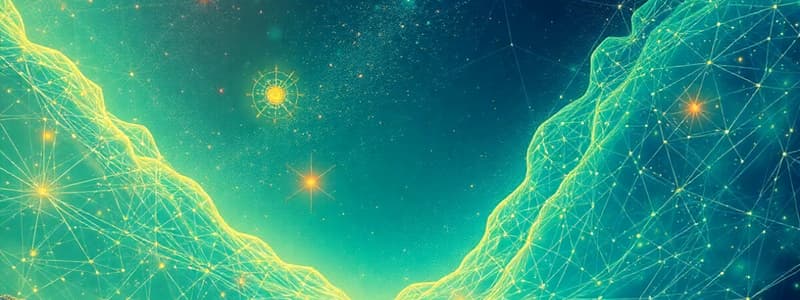Podcast
Questions and Answers
Wat is it wichtichste ferskil tusken it brken fan localStorage en sessionStorage yn JavaScript?
Wat is it wichtichste ferskil tusken it brken fan localStorage en sessionStorage yn JavaScript?
- `localStorage` is beskikber foar alle browsers, wylst `sessionStorage` allinnich yn moderne browsers wurket.
- `localStorage` hat gjin ferfaltiid, wylst `sessionStorage` de gegevens ferliest as de browser sluten wurdt. (correct)
- `localStorage` bewarret gegevens foar in spesifike sesje, wylst `sessionStorage` gegevens permanint bewarret.
- `localStorage` kin allinnich brkt wurde foar it bewarjen fan lytse stikjes tekst, wylst `sessionStorage` brkt wurde kin foar komplekse objekten.
Stel dat jo in webapplikaasje ntwikkelje dy't brkersgegevens bewarje moat, sels as de brker de browser slt en letter wer iepenet. Hokker opslachmeganisme is it meast geskikt?
Stel dat jo in webapplikaasje ntwikkelje dy't brkersgegevens bewarje moat, sels as de brker de browser slt en letter wer iepenet. Hokker opslachmeganisme is it meast geskikt?
- `sessionStorage`
- `localStorage` (correct)
- Cookies mei in koarte ferfaltiid.
- In fariabele yn it JavaScript-bestn.
Wat is de funksje fan de metoade setItem() by it brken fan localStorage?
Wat is de funksje fan de metoade setItem() by it brken fan localStorage?
- It leegjen fan de hiele `localStorage`.
- It tafoegjen of bywurkjen fan in item yn `localStorage`. (correct)
- It opheljen fan de grutte fan de `localStorage`.
- It fuortsmiten fan in item t `localStorage`.
Jo wolle alle gegevens t localStorage wiskje. Hokker metoade brke jo?
Jo wolle alle gegevens t localStorage wiskje. Hokker metoade brke jo?
Wat is in wichtich neidiel fan it opslaan fan grutte hoemannichten gegevens yn localStorage?
Wat is in wichtich neidiel fan it opslaan fan grutte hoemannichten gegevens yn localStorage?
Flashcards
Wat is in programmeartaal?
Wat is in programmeartaal?
In set fan regels foar it skriuwen fan koade dy't kompjûters begripe kinne.
Wat is in fariabele?
Wat is in fariabele?
In namme dy't ferwiist nei in wearde dy't yn it kompjûterûnthâld bewarre wurdt.
Wat is in operaasje?
Wat is in operaasje?
In spesifike aksje dy't troch in programmeartaal útfierd wurde kin, lykas optellen of ôftrekken.
Wat is in booleaanse útdrukking?
Wat is in booleaanse útdrukking?
Signup and view all the flashcards
Wat is in 'if-else'-ferklearring?
Wat is in 'if-else'-ferklearring?
Signup and view all the flashcards
Study Notes
- The provided document is a comprehensive guide about Convolutional Neural Networks (CNNs).
- CNNs are a class of deep neural networks, most commonly applied to analyzing visual imagery.
Core Concepts of CNNs
- CNNs are designed to process data that has a grid-like topology.
- Examples of grid-like data are images (2D grid of pixels) and time series data (1D grid representing temporal sequence).
- CNNs use convolution operations instead of general matrix multiplication in at least one of their layers.
- A convolution replaces the general matrix multiplication operation.
- Convolutional layers possess three main types of parameters: learnable filters, pooling layers, and activation functions.
- These parameters, distinct from the weights in fully connected layers, give CNNs their ability to extract hierarchical features from data.
- CNNs excel in tasks where the order or spatial arrangement of the data is crucial.
- Applications of CNNs include image and video recognition, natural language processing, and time series analysis.
Advantages of CNNs
- CNNs are more efficient than standard neural networks, especially for large inputs, due to parameter sharing and local connectivity.
- Parameter sharing in CNNs means that the same filter (or kernel) is used across different locations in the input.
- Local connectivity implies that each neuron in a convolutional layer connects only to a small region of the input volume.
- CNNs exhibit translation invariance, thanks to the weight sharing scheme.
- Translation invariance means that CNNs can detect features regardless of where they appear in the input.
- CNNs can automatically learn spatial hierarchies of features.
- Earlier layers detect basic features (edges, corners).
- Later layers assemble these into more complex features.
- Depth allows CNNs to be robust to variations.
- Depth allows CNNs to be robust to variations in the input data, such as changes in viewpoint or illumination.
Key Components of CNNs
Convolutional Layer
- The core building block of a CNN.
- It performs a convolution operation on the input, using a set of learnable filters.
- The filters detect specific features or patterns in the input.
- During the forward pass, the convolutional layer slides each filter across the input.
- It computes the dot product between the filter and the corresponding input region.
- This sliding and dot product operation produces a feature map.
- Multiple filters in a convolutional layer produce multiple feature maps.
- Feature maps form the output of the layer.
- The output of the layer goes to the next layer.
- The size of the filter, stride, and padding are hyperparameters for controlling the behavior of a convolutional layer.
- The filter size determines the spatial extent of the input that each filter connects to.
- The stride controls the step size of the filter as it slides across the input.
- Padding adds layers of zeros around the input boundary to control the spatial size of the output feature maps.
- The depth of a convolutional layer is equal to the number of filters used.
Pooling Layer
- Pooling layers reduce the spatial size of the representation.
- Pooling layers also reduce the number of parameters and computation in the network.
- Pooling layers help to control overfitting.
- Max pooling and average pooling are common types of pooling layers.
- Max pooling selects the maximum value from each patch of feature map.
- Average pooling computes the average value from each patch of feature map.
- Pooling layers operate independently on every depth slice of the input.
- Pooling layer hyperparameters include the filter size and stride.
Activation Function
- Activation functions introduce non-linearity to the CNN.
- Non-linearity allows the network to learn complex patterns.
- ReLU (Rectified Linear Unit) is a popular activation function.
- Sigmoid and Tanh are other activation functions, though less commonly used in modern CNNs due to issues like vanishing gradients.
Fully Connected Layer
- Fully connected layers are typically placed at the end of the CNN architecture.
- Neurons in a fully connected layer have full connections to all activations in the previous layer.
- Fully connected layers perform high-level reasoning.
- Fully connected layers combine the features extracted by the convolutional layers to make a final prediction.
CNN Architectures
- CNN architectures are arrangements of the different layers to form a complete model.
- LeNet-5, AlexNet, and VGGNet are classic CNN architectures.
- These architectures have significantly influenced the field.
- LeNet-5 was designed for digit recognition.
- AlexNet demonstrated the power of deep CNNs on large datasets.
- AlexNet won the 2012 ImageNet competition.
- VGGNet explored the impact of network depth, utilizing very small (3x3) convolution filters.
- ResNet (Residual Network) and Inception are modern architectures.
- ResNet introduced residual connections to train deeper networks.
- Inception networks use a more complex architecture with multiple filter sizes in parallel.
- The choice of architecture depends on the specific task.
- The choice of architecture also depends on the available computational resources.
Training CNNs
- Training a CNN involves feeding the network with labeled data.
- Training a CNN involves adjusting the network's parameters to minimize a loss function.
- Backpropagation is used to compute the gradients of the loss function with respect to the network's parameters.
- Optimization algorithms like Stochastic Gradient Descent (SGD) and Adam are used to update the parameters.
- Hyperparameter tuning is a crucial aspect of training CNNs.
- Hyper parameter optimization is used to find the optimal values for parameters like learning rate, batch size, and regularization strength.
- Techniques like data augmentation, dropout, and batch normalization can improve the generalization performance of CNNs.
- Data augmentation artificially increases the size of the training set by applying transformations to the existing data.
- Dropout randomly sets a fraction of the neurons to zero during training.
- Batch normalization normalizes the activations of each layer to stabilize learning and reduce training time.
Applications of CNNs
Image Recognition and Classification
- CNNs can automatically learn features from images and classify them into different categories.
- Models like AlexNet, VGGNet, ResNet, and Inception are used for image recognition tasks.
Object Detection
- CNNs can identify and locate multiple objects within an image.
- R-CNN, Fast R-CNN, Faster R-CNN, and YOLO (You Only Look Once) are popular object detection models.
Image Segmentation
- Image segmentation involves partitioning an image into multiple segments or regions.
- Each region corresponds to a different object or part of an object.
- Fully Convolutional Networks (FCNs) and U-Net are architectures for image segmentation.
Natural Language Processing (NLP)
- CNNs can be applied to various NLP tasks.
- Text classification and sentiment analysis are common NLP tasks.
- CNNs can capture local dependencies and patterns in text data.
Time Series Analysis
- CNNs can analyze sequential data and extract meaningful features.
- CNNs perform anomaly detection and forecasting.
- CNNs can identify patterns in financial data or sensor data.
CNNs vs. Traditional Neural Networks
- CNNs use convolutional layers, pooling layers, and activation functions as their main building blocks.
- Traditional Neural Networks (NNs) primarily use fully connected layers.
- CNNs are designed to automatically and adaptively learn spatial hierarchies of features.
- CNNs have been proven very powerful in image recognition.
- CNNs require less pre-processing.
- CNNs are good at extracting features.
- CNNs need large training sets.
- CNNs are computationally expensive.
- CNNs offer improved performance, especially in tasks with structured data.
- CNNs require careful hyperparameter tuning.
- CNNs are less flexible than feedforward NNs.
Studying That Suits You
Use AI to generate personalized quizzes and flashcards to suit your learning preferences.




